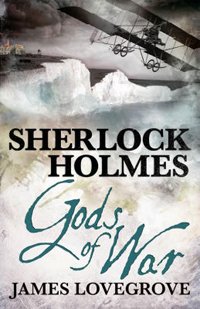Last year we reviewed The Stuff of Nightmares, a Holmesian pastiche with science fiction and steampunk elements in which Lovegrove successfully steered a line between pleasing fans of traditional Conan Doyle mysteries and provided something new for readers. He returns now with an adventure set during Homes’ retirement.
It is 1913 and Holmes has moved to the Sussex countryside to live out his twilight years keeping bees. Watson has come for one of his periodic visits from the capital in expectation of a quiet week with his old comrade. Instead he is met at Eastbourne station by his friend in a state of excitement. The game is afoot! Holmes has been engaged to solve a locked-room mystery – a local jeweller’s vault has been breached and his most valuable items pilfered. The only possible places of entry are the vault door, which shows no sign of being tampered with, and a window so small even a child couldn’t get through. The only clue is the disappearance of the owner’s apprentice, last seen drinking with some shady characters the night before. It proves anything but a three-pipe problem for the master detective but serves as an interesting prelude to the mystery proper.
The next morning, whilst taking a stroll on the beach, Holmes and Watson come across the mangled corpse of a young man. His condition suggests he has fallen from a great height, but he is nowhere near the famous cliffs at Beachy Head. At the same time he is unlikely to have drowned, having fallen from a trawler, since he is covered with the wrong type of mud. The young man, Patrick Mallinson, turns out to be the son of the extremely wealthy industrialist Craig Mallinson. The latter hires Holmes to set his mind at rest. His son has had his heart broken recently, and his father wants conclusive proof, if possible, that his son’s death is suicide and not the result of a business rival trying to destabilise his empire.
Holmes and Watson’s first port of call is to Patrick’s lover. Elizabeth Vandenbergh’s story provides more questions than answers. She broke off their affair as a last resort because of his increasingly out-of-character behaviour. Patrick was having mood swings and would not divulge what was bothering him. Elizabeth had reason to believe Patrick was involved in a secret society that dabbled in the occult, and couldn’t find a way out.
As our intrepid pair dig further into the mystery they discover Craig Mallinson is not the only industrialist to suffer a devastating personal loss. With the whole of Europe a powder-keg, ready to explode into war at any moment, Holmes and Watson must solve this mystery before Britain’s ability to fight her corner is severely compromised.
This is much more a traditional pastiche than The Stuff of Nightmares. Occult themes may be central to the plot but its solution is decidedly in our earthly realm. That doesn’t mean it is without any scary moments, indeed the best parts of the book are when Holmes and Watson are in peril – as an intended sacrifice to pagan gods – and when the pair are chased over the foggy moor in a scene no doubt done in tribute to The Hound of the Baskervilles.
My only complaint about the book is that a lack of possible villains does make it relatively easy to work out who is behind the murder, but at least their motives are obscured for most of the narrative. Overall, Gods of War hits the spot as a quick, fun fix and is recommended for Sherlockians everywhere.
Titan Books
Print
£5.51
CFL Rating: 4 Stars









